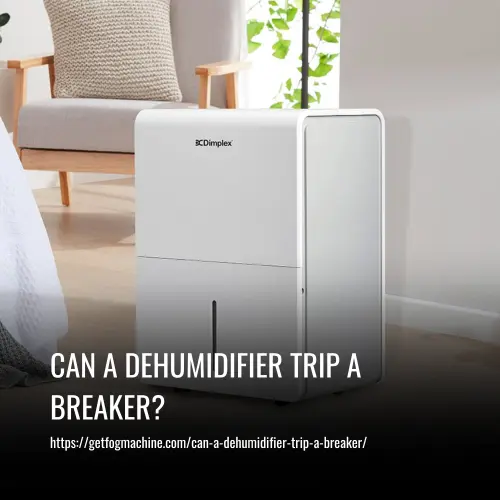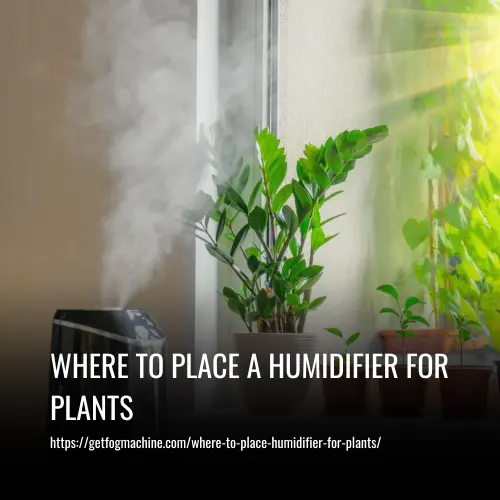Can A Dehumidifier Trip A Breaker?
This post contains affiliate links. As an Amazon Associate, we earn from qualifying purchases.
Yes, a dehumidifier can trip a breaker, especially if it’s drawing too much power. Dehumidifiers, like other appliances, have specific power requirements. If the electrical circuit supplying power to the dehumidifier isn’t able to handle the appliance’s energy needs, it can trip the breaker to prevent an overload.

Why Does a Dehumidifier Trip the Breaker
Dehumidifiers are essential machines that remove excess moisture from the air and help control humidity levels in your home or office. However, it’s not uncommon for these machines to trip circuit breakers, causing inconveniences. Here we will explore some possible causes of this irregularity and how to address them.
1. Faulty Electrical Panel
A dehumidifier tripping a circuit breaker might have nothing to do with the unit itself, but rather the electrical panel or the breaker. You can troubleshoot this issue by connecting the machine to another breaker through an extension cord. If the breaker trips, the problem could be with your dehumidifier. However, if it does not trip, the issue might be a worn-out breaker or damaged electrical panel that needs replacement. A licensed electrician can diagnose the problem and offer the appropriate solution.
2. Overloaded, Shared Circuit
If your dehumidifier shares a circuit with other appliances or tools, you might be overloading the circuit, leading to the trip. Make sure to use a dedicated circuit to power your dehumidifier and ensure that its ratings match the circuit ratings to prevent overloading.
3. Dirty Dehumidifier Filter
The air filter inside a portable dehumidifier can collect dirt and dust particles over time, reducing the airflow and forcing the machine to draw more power, which can trip the breaker. Check and clean the filter regularly to solve this issue.
4. Dirty Dehumidifier Evaporator Coils and Fins
When the evaporator coils and fins of your dehumidifier are clogged, it can cause the unit to work extra hard and consume more power. Clean the coils and fins regularly with a stiff brush to prevent the trip.
5. Defective Air Blower Motor
If the air blower motor is faulty, it can cause a spike in power intake, leading to the trip. This issue requires a deeper inspection, and you might need a professional’s help to diagnose and fix it.
What Parts of a Dehumidifier Need Power
When you turn on a dehumidifier, it needs an electrical supply to operate. It is crucial to understand which parts require electricity to function to ensure the machine runs efficiently.
1. Air Blower Fan Motor
The air blower fan motor is an essential component of a dehumidifier. It pulls air into the unit for water removal and blows it out after the dehumidification process. The air wouldn’t circulate without the fan, rendering the machine ineffective. If the fan motor is faulty, the evaporator coils might freeze and cause the compressor to shut down, and your unit will start and stop without effectively dehumidifying any air.
2. Compressor
The compressor is responsible for compressing the evaporator gas. It draws power to function correctly, and its primary function is to convert a gaseous refrigerant to a liquid state. The evaporator gas must transform back into a gas to initiate the condensation process. The compressor also has an evaporator valve sensor that regulates the compressor intake. This sensor prevents the compressor from taking in any liquid evaporator to avoid damage.
3. Control Panel
Apart from the mechanical parts, the control panel also requires electrical power to enable you to use your dehumidifier’s advanced settings. The control panel houses the LED screen and buttons that allow you to set the humidity levels and the timer for the dehumidifier to run. A humidity sensor beneath the control panel is responsible for monitoring the relative humidity levels and relaying the information to the control board.
4. Water Pump
Some dehumidifiers come with an inbuilt water pump that pumps out the condensate instead of relying on gravity drainage. The water pump is typically part of the main unit’s motherboard and requires electricity to run. A float switch connected to the water pump turns it on when the water level reaches a specified level.
Preventative Measures To Avoid Tripping
Your dehumidifier contributes a lot to your indoor comfort. However, experiencing a tripped breaker can be frustrating and inconvenient. The good news is that it’s possible to prevent this from happening in the first place. Here we take a look at some preventive measures that you can undertake to ensure that your dehumidifier operates smoothly.
1. Install a Dedicated Circuit
One common reason why your dehumidifier can trip your breaker is due to an overloaded circuit. When too many appliances and devices are drawing power from the same electrical line, it causes too much current to flow through the wires. This eventually leads to your breaker switching off.
To solve this issue, install a separate circuit solely dedicated to your dehumidifier. This approach ensures that no other high-power-consuming gadgets are connected to the same line, reducing the likelihood of overloading your circuit.
2. Regular Inspections and Cleaning of your Dehumidifier’s Air Filter
Dirt buildup in your dehumidifier’s air filter can increase energy consumption and strain the motor. You can avoid this by regularly inspecting and cleaning your air filter. Clean the filter as per the manufacturer’s instructions to ensure that it is free of dirt and dust. This will also improve your indoor air quality by eliminating debris and producing cleaner, fresher air.
3. Invest in an Overload Protection Dehumidifier
Another effective way to prevent your dehumidifier from tripping your breakers is by investing in a model specifically designed with overload protection features that automatically shut off the unit when it draws too much power. This protects the unit from overheating and malfunctioning, ensuring smooth operation even during hot and humid seasons.
FAQs
The most common reason a dehumidifier trips a breaker is when it’s plugged into a circuit that already has multiple appliances running or when the circuit is unable to handle the dehumidifier’s power requirements. It can also trip due to a faulty dehumidifier or issues within the electrical system.
To prevent tripping the breaker, ensure your dehumidifier is plugged into a dedicated outlet or a circuit with fewer appliances running simultaneously. Check the dehumidifier’s power requirements and ensure the circuit can handle the load. Avoid using extension cords or power strips, as these can contribute to power issues.
If your dehumidifier repeatedly trips the breaker, unplug it and let it sit for a while to cool down. Check for any visible damage or signs of overheating on the dehumidifier. Consider having an electrician inspect the circuit to ensure it’s capable of handling the dehumidifier’s power requirements without issues.
Yes, a malfunctioning dehumidifier can cause a breaker to trip. Internal issues such as a short circuit or a failing component within the dehumidifier itself can lead to an increased power draw, triggering the breaker.
If the breaker trips due to the dehumidifier, it’s generally safe to reset it after identifying and addressing the cause. However, if the breaker continues to trip frequently, it’s essential to investigate further or seek professional assistance to avoid potential electrical hazards or damage to the dehumidifier.
It is possible to run your dehumidifier 24/7 without damaging it. However, it’s important to consider the unit’s daily water removal capacity and the need to empty the tank. If the tank fills up, the unit will shut down to avoid overflowing and causing flooding.
A dehumidifier needs a dedicated circuit to function properly and prevent tripping the breaker. This means that the circuit should have its own electrical panel and not be shared with other appliances. Installing a GFCI-protected outlet in the designated crawl or living space is best. While it may be possible to use an existing GFCI outlet, it is important to ensure that it is not shared with any other appliance to avoid overloading the circuit.
Dehumidifiers consume a considerable amount of electricity. Though some models have low wattage, they run for at least 12 hours daily and even 24 hours in most cases. Therefore, electricity costs can increase, particularly for less efficient models, leading to higher energy consumption.
Conclusion
In conclusion, a dehumidifier can definitely trip a breaker in your electrical panel if it is not on a dedicated circuit. This article has provided you with the common reasons why circuit breakers trip and how to address them. Make sure your dehumidifier is on a dedicated circuit to avoid overloading and tripping the circuit breaker.
Check for loose connections, wire insulation, and other issues that may cause breaker trips. By using this information, you will be able to avoid electrical issues and keep your living space safe and comfortable.






